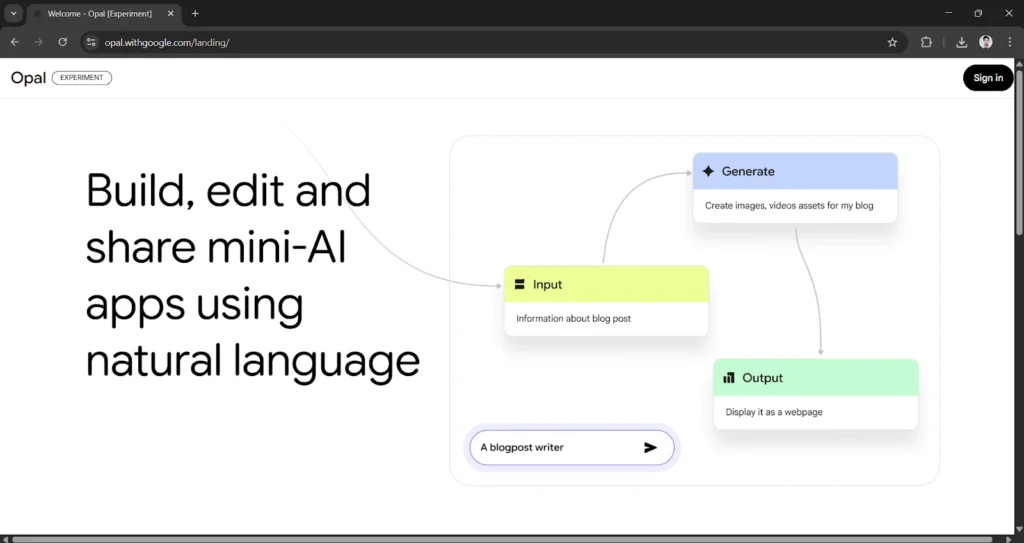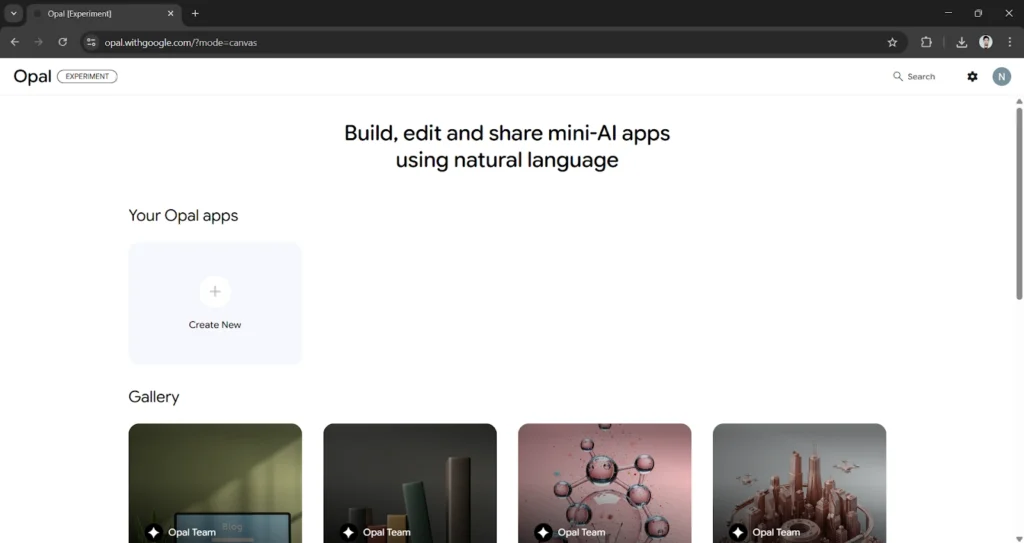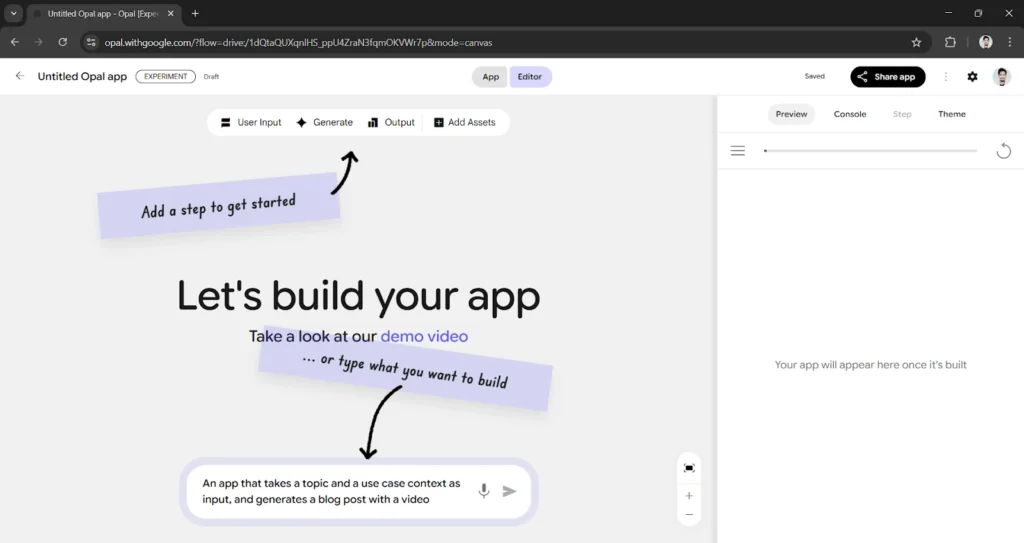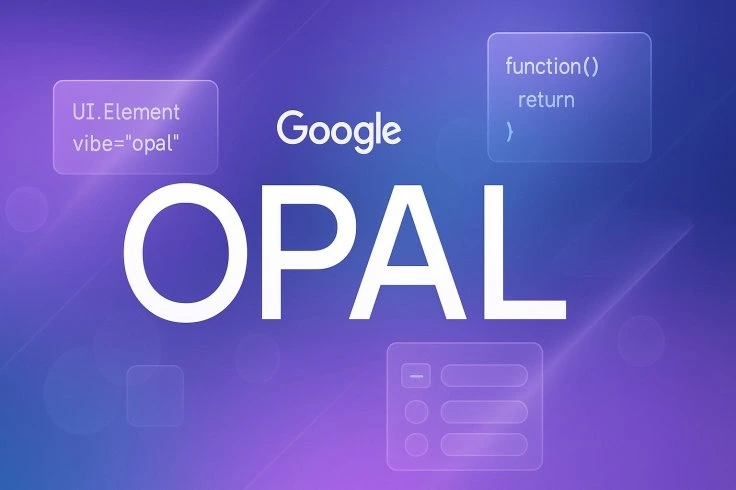What is Google Opal?
Google Opal is an experimental, no-code platform from Google Labs. It enables users to build diverse mini-applications by simply giving it a prompt. Unlike traditional app development that relies on writing code, Opal uses a visual editor and a unique approach through natural language descriptions. This means you don’t need to write a single line of code to bring your ideas to life.
Key Features of Google Opal
- Natural Language Building (Vibe Coding): Instruct Opal in plain English to chain together AI models, prompts, and tools, creating multi-step workflows.
- Visual Workflow Editor: Opal generates a clear, node-based flowchart based on your descriptions, visually illustrating your app’s functionality.
- Leverages Google AI Models: Your mini-apps are powered by various Google models like Gemini Flash 2.0, Imagen (for images), Audio LM (for speech), and VO (for video). You can also switch models when remixing.
- Flexible Editing: Refine creations by continuing the conversation with Opal or directly manipulating the visual workflow. Edit prompts, add features, integrate tools, or build from scratch. App themes are also customizable.
- Instant Sharing: Share your mini-app easily with a unique link. While custom domains aren’t direct, you can redirect your own domain to the Opal URL.
- Starter Templates & Remixing: Begin with pre-built demo apps or “remix” them for customization. Remixing encourages collaboration, allowing others to build upon your applications.
- Automate Tasks: Opal excels at automating daily tasks and creating personal tools, such as a blog post writer, fashion stylist, or YouTube thumbnail generator.
Limitations of Opal
Opal is an experimental tool in its early stages. Users may encounter limitations like API call issues or “quota exceeded” errors, leading to failed generations without clear, immediate feedback. Real-time quota tracking is absent. It is not designed to replace full-stack engineering.
Step-by-Step Guide: How to Use Google Opal
Ready to create your own AI mini-app? Follow these steps:
1. Access Google Opal:
Opal is currently available only in the US. If outside the US, use a VPN (e.g., Brosk, Proton).Go to opal.withgoogle.com.

2. Sign In:
Sign in using your Google account.
3. Explore or Create:
From the dashboard, explore demo apps or “remix” them. Click “Create New” to start from scratch.

4. Describe Your App (Vibe Coding):
Describe your desired application using natural language (e.g., “an app that explains a topic like I’m five”).Alternatively, drag and drop elements (user input, generate, output, assets) onto the canvas and link them.

5. Build and Customize the Workflow:
Opal generates a visual flowchart based on your prompt. Customize steps, instructions, or templates. Edit prompts and switch Google AI models (e.g., Gemini Flash 2.0) within each step. Adjust the app’s theme.

6. Test Your Mini-App:
Preview your app directly in the editor via the “App” tab or “start” button. Use the “console” tab to check for errors or monitor workflow progress.
7. Share Your Creation:
Click “share app” to get a unique link.Share the link; users can access and “remix” your app.
Google Opal embodies putting powerful “vibe coding” capabilities into everyday users’ hands. While experimental, its ability to build, edit, and share apps using simple prompts shows huge potential for the “describe, don’t code” era.
Google Opal vs. Other AI Automation Tools: A Comparative View
Opal differentiates itself through deep integration with Google’s AI ecosystem and a strong focus on natural language.
| Feature/Tool | Google Opal | Zapier | Make.com (formerly Integromat) | n8n |
| Core Purpose | No-code AI mini-app generation via natural language; rapid prototyping. | Workflow automation; connecting disparate apps. | Complex workflow automation; data integration. | Extensible workflow automation; self-hostable. |
| Primary Interaction | Natural language prompts + Visual flow editor. | Trigger-action recipes (Zaps). | Visual drag-and-drop scenario builder. | Visual node-based workflow editor. |
| AI Integration | Deeply integrated with Google’s proprietary AI models. | Integrates with third-party AI tools via API calls. | Integrates with third-party AI tools via API calls. | Integrates with third-party AI tools via API calls; open-source. |
| Target User | Non-technical users, hobbyists, creators. | Business users, marketers, small teams. | Power users, developers, businesses needing complex automation. | Developers, technical users, businesses. |
| Ease of Use | Very High (focus on “vibe coding”). | High (intuitive UI). | Moderate to High. | Moderate. |
| Customization | Flexible via conversational prompts and visual editor. | Limited to pre-defined actions. | Highly customizable with HTTP requests, webhooks. | Highly customizable with custom code. |
| Scalability | Experimental; for mini-apps. | Good for moderate automation. | Excellent for high-volume, complex automation. | Good for self-hosted, scalable workflows. |
| Deployment | Google Labs web platform (US-only beta). | Cloud-based SaaS. | Cloud-based SaaS. | Cloud-based or self-hostable. |
| Cost | Free during experimental phase. | Tiered pricing. | Tiered pricing. | Free (self-hosted) or tiered pricing (cloud). |
| Learning Curve | Low. | Low. | Medium. | Medium to High. |
| Unique Selling Point | AI-native app building with natural language. | Simplicity and breadth of integrations. | Power and flexibility for complex data. | Open-source, self-hostable. |
Export to Sheets
Current Opinions on Google Opal
Initial reactions to Google Opal are largely positive, highlighting its potential to lower the barrier to entry for AI-powered application development.
- Accessibility: Enthusiasm exists for Opal’s “vibe coding,” empowering non-technical users to create functional tools and democratizing AI app creation.
- Rapid Prototyping: Praised for quickly bringing ideas to life and easy iteration through its visual workflow.
- Educational Tool: Seen as an excellent way for students and hobbyists to understand AI concepts and build practical applications without coding.
- “Experimental” Limitations: Critiques often point to its experimental nature, with frequent “quota exceeded” errors or silent generation failures, and a lack of real-time feedback.
- Not a Professional Replacement: Widely understood that Opal, currently, is not for complex, production-grade applications but is best suited for “mini-apps” and personal automation.
- Community Potential: The “remix” feature is highly regarded for fostering a collaborative community, echoing open-source principles.
Any Controversies Surrounding Google Opal?
As an experimental Google Labs tool in public beta, there are no significant controversies directly surrounding Google Opal itself. However, as with any AI-powered tool that simplifies content generation and app creation, broader discussions and potential concerns may arise as Opal evolves. These include:
Resource Consumption and Quotas: Managing computational resources and providing transparent access as usage scales.
Misinformation and Bias: Potential for creating and disseminating misinformation or applications with inherent biases from underlying AI models.
“Black Box” Concerns: Difficulty in understanding why an AI generates particular outputs, leading to a lack of transparency.
Dependence on Google’s Ecosystem: Questions about vendor lock-in and portability of applications built exclusively on the platform.
Microsoft has potentially launched a technology poised to transform the entire internet with the release of NLWeb. Announced at Build 2025, this open-source project, seemingly simple, has the power to turn any website into an AI application in seconds.
FAQ of Google Opal
1.What exactly is “Vibe Coding”?
“Vibe Coding” in Google Opal refers to the process of creating applications by describing your desired functionality in natural, conversational language, rather than writing traditional programming code. You communicate your “vibe” or intent, and Opal’s AI translates it into a functional workflow.
2.Do I need any coding experience to use Google Opal?
No, Google Opal is designed as a no-code platform. Its primary goal is to empower individuals without any programming background to build AI-powered mini-apps using intuitive natural language prompts and a visual workflow editor.
3.What kind of mini-apps can I create with Google Opal?
You can create a wide variety of mini-apps for task automation and personal tools. Examples include content generators (blog posts, social media captions), image generators (thumbnails, creative assets), simple data processors, explanation tools, and more complex multi-step workflows.
4.Is Google Opal available globally?
Currently, Google Opal is in its experimental public beta phase and is only officially available to users located in the US. Users outside the US typically require a VPN to access the platform.
5.Is Google Opal a replacement for professional software development?
No, in its current experimental stage, Google Opal is not intended to replace professional full-stack software development. It is optimized for rapid prototyping, personal automation, and creating focused mini-applications, rather than complex, scalable enterprise solutions.
6.What are the main limitations or challenges when using Google Opal?
As an experimental tool, current limitations include occasional API call issues or “quota exceeded” errors that can lead to failed generations without clear, immediate feedback. There’s also no real-time quota tracking, and it’s not designed for building large-scale, mission-critical applications.
Sources of Information
Find more AI news here !



